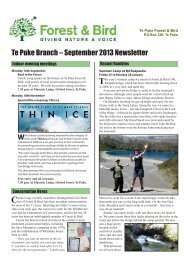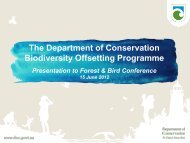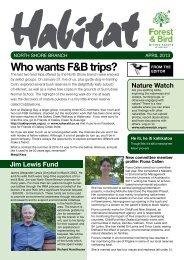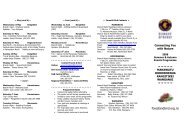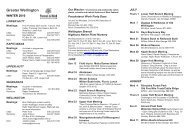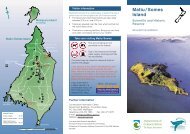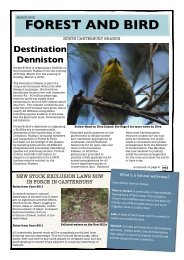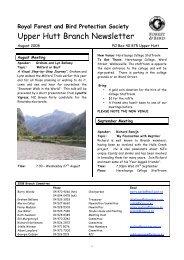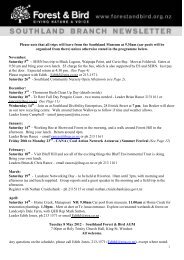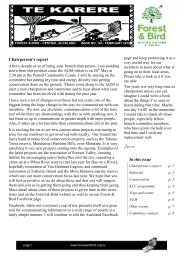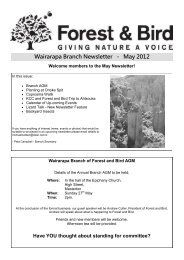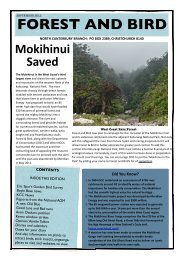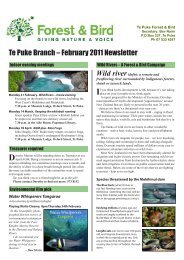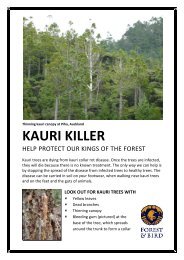methodology - Forest and Bird
methodology - Forest and Bird
methodology - Forest and Bird
Create successful ePaper yourself
Turn your PDF publications into a flip-book with our unique Google optimized e-Paper software.
Developing fishery - a fishery in which experimental or feasibility fishing is being undertaken to determine<br />
whether the resource can support a viable fishery.<br />
Dip-net - A net used for transferring the catch of a deep-sea seine after it has been brought alongside. It is<br />
operated either entirely by h<strong>and</strong> or partly by h<strong>and</strong> <strong>and</strong> partly by mechanical power. Other names<br />
are scoop, brailer, spoon net, brail net, <strong>and</strong> h<strong>and</strong> brailer.<br />
Driftnet - a gillnet weighted at the bottom <strong>and</strong> supported by floats at the top which drifts with the tide or<br />
current. Large driftnets used to be in excess of 50 km on the high seas <strong>and</strong> in New Zeal<strong>and</strong> EEZ can<br />
be no longer than 1km.<br />
Dragnet – a small net pulled by two or more people which is dragged along the bottom.<br />
EEZ - Exclusive Economic Zone - the zone from 12 nautical miles out to 200 nautical miles offshore<br />
established pursuant to international agreement under the United Nations Convention on the Law<br />
of the Sea.<br />
Fishing effort - the amount of fishing activity undertaken. It is usually measured by the total time spent<br />
fishing combined with the quantity of gear used, for example the catch per thous<strong>and</strong> hooks or the<br />
catch per trawl. This provides the level of effort in CPUE. Nominal fishing effort provides an<br />
indirect measure of fishing mortality.<br />
Fecundity - the level or rate of egg or offspring production. Fecundity may change with the size <strong>and</strong> age of a<br />
species.<br />
Finning - the practice of cutting off the fins of sharks <strong>and</strong> discarding the carcasses overboard. Asia is the<br />
primary market for shark fins, which are used to make shark fin soup. Congress banned sharkfinning<br />
in all U.S. waters in 2000.<br />
Fishery - can be defined in many ways though, in general terms, it is the take or removal of a species from<br />
the aquatic environment using some type of fishing technology. The emphasis is on the human<br />
aspects of fishing <strong>and</strong> all the activities it involves.<br />
Food chain - the sequence of organisms through which energy <strong>and</strong> materials are transferred (in the form of<br />
food), or the linear progression of feeding levels in which one organism is the food source for the<br />
next.<br />
Food web - the complex, interlocking series of individual food chains in an ecosystem, i.e., all the predatorprey<br />
relationships.<br />
Fyke net – A long bag net distended by hoops, into which fish can pass easily, without being able to return.<br />
Globally threatened species - a species that is globally threatened with biological extinction under the<br />
World Conservation Union criteria, which are Critically Endangered, Endangered <strong>and</strong> Vulnerable.<br />
Growth over-fishing - this is when the losses due to natural <strong>and</strong> fishing mortality exceeds the gains due to<br />
recruitment <strong>and</strong> growth during the same period. This is usually reflected by a reduction in the size<br />
of the fish being harvested.<br />
High-grading - the practice of discarding at sea all or a portion of a vessel's legal catch in order to obtain a<br />
higher or larger grade of fish that brings higher prices. It may occur in both quota <strong>and</strong> nonquota<br />
fisheries. (Roberts et al.,.)<br />
Hinaki – traditional Maori woven eel net traps made from supplejack <strong>and</strong> flax.<br />
Invertebrate - jellyfish, octopus <strong>and</strong> sponge are examples of marine invertebrates, or animals without a<br />
backbone. In fishery management terms, invertebrate usually refers to shellfish, such as lobsters,<br />
shrimp, oysters <strong>and</strong> scallops.<br />
Jig - a multi-barbed hook used mainly to catch squid.<br />
Lampara net - Similar to, but much smaller than, a purse seine with no pursing action. This net is generally<br />
used for catching artificial light attracted schools of small fish such as anchovy <strong>and</strong> pilchard. There<br />
is a central spoon-shaped section <strong>and</strong> two lateral wings <strong>and</strong> the net is usually operated from a<br />
small boat. The rapid retrieval of the lead line does close the bottom of the net but it is not a true<br />
purse.<br />
L<strong>and</strong>ings - commercial l<strong>and</strong>ings are defined as the quantity of fish <strong>and</strong> shellfish brought ashore for sale. The<br />
term also applies to the amount caught for personal use by recreational fishermen. This<br />
measurement does not include the amount of bycatch incidentally caught <strong>and</strong> discarded dead at<br />
sea.<br />
Maximum sustainable yield - the maximum amount of a species that can be taken without diminishing the<br />
future take.<br />
Metric tonne - often the unit of measurement for commercial <strong>and</strong> recreational l<strong>and</strong>ings, a metric tonne is<br />
equal to 1000 kilograms, 0.984 long tons, 1.1023 short tons, or 2204.6 pounds.<br />
<strong>Forest</strong> & <strong>Bird</strong> Best Fish Guide 2012 – 2013: Criteria for Ecological Rankings 41



